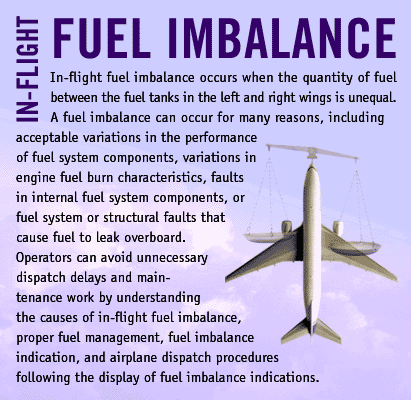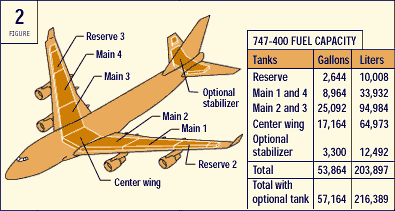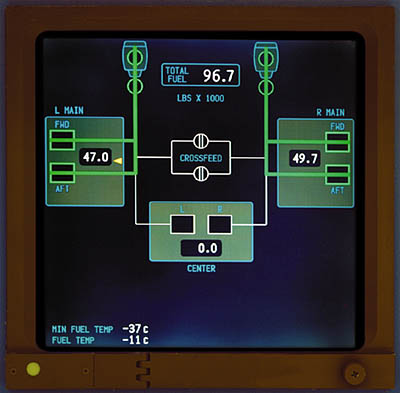Published: January 2000

When fuel is being used from an airplane’s wing tanks in flight, normal fuel management procedures require keeping equal quantities of fuel in each wing to maintain airplane lateral balance. An in-flight fuel imbalance condition occurs if the fuel quantities in the wings become unequal. To maintain equal quantities in each wing and ensure a high level of airplane dispatch reliability, even after display of a fuel imbalance indication, operators should understand:
- Proper fuel management.
- Causes of in-flight fuel imbalance.
- Fuel imbalance indications.
- Fuel imbalance procedures.
- Airplane dispatch after display of fuel imbalance indication.
- Resources for addressing in-flight fuel imbalance
1. PROPER FUEL MANAGEMENT
 Before flight, the fuel load between the left and right wing tanks must be symmetrical to maintain airplane lateral balance. On two- and four-engine airplanes, fuel is first distributed equally to the wing tanks until those tanks are full figs. 1 and 2). Any additional fuel required for flight is loaded in the centre tank and any auxiliary fuel tanks, such as the horizontal stabiliser tank on the 747-400.
Before flight, the fuel load between the left and right wing tanks must be symmetrical to maintain airplane lateral balance. On two- and four-engine airplanes, fuel is first distributed equally to the wing tanks until those tanks are full figs. 1 and 2). Any additional fuel required for flight is loaded in the centre tank and any auxiliary fuel tanks, such as the horizontal stabiliser tank on the 747-400.
 On three-engine airplanes fig. 3), fuel is first distributed equally to the wing tanks and the centre tank until the wing tanks are full. Any additional fuel required is then distributed to the remaining volume in the centre tank and in any auxiliary fuel tanks.
On three-engine airplanes fig. 3), fuel is first distributed equally to the wing tanks and the centre tank until the wing tanks are full. Any additional fuel required is then distributed to the remaining volume in the centre tank and in any auxiliary fuel tanks.
 On two- and four-engine airplanes, centre tank fuel and auxiliary tank fuel are generally used first. Once these tanks are empty, fuel is used from the wing tanks. On three-engine airplanes, centre tank fuel and any auxiliary tank fuel is used until the remaining fuel in the centre tank equals the fuel quantity in the tanks on the left and right wings. At this point, fuel is used equally from the wing tanks and centre tank.
On two- and four-engine airplanes, centre tank fuel and auxiliary tank fuel are generally used first. Once these tanks are empty, fuel is used from the wing tanks. On three-engine airplanes, centre tank fuel and any auxiliary tank fuel is used until the remaining fuel in the centre tank equals the fuel quantity in the tanks on the left and right wings. At this point, fuel is used equally from the wing tanks and centre tank.
2. CAUSES OF IN-FLIGHT FUEL IMBALANCE
Conditions frequently identified as being responsible for in-flight fuel imbalance include differences in fuel system component performance, different rates of engine fuel burn, internal fuel system failures, or fuel system or structural faults. Several other conditions in the following list were identified from maintenance investigations of reported fuel imbalance events. Some imbalances were caused by a combination of these conditions:
- Variations in fuel pump output pressure between fuel tanks.
- Variations in fuel requirements between the left and right engines.
- Fuel pump check valve failures.
- Internal manifold and coupling leaks.
- Centre wing tank jettison transfer valve failures (747).
- Hydro-mechanical scavenge system.
- Debris and contamination in the tanks.
- Fuel quantity indication system (FQIS) anomalies.
- Structural fuel leaks or transfer between tanks.
Maintenance troubleshooting can be relatively easy on two-engine airplanes because the fuel system can be isolated to the left and right sides of the airplane. However, it can be much more difficult to isolate the cause to any particular component on the 747, and it may be necessary to enter the fuel tank to determine the cause of the imbalance.
3. FUEL IMBALANCE INDICATIONS
 On out-of-production airplanes such as the 727 or 747-200, the flight engineer managed fuel use and monitored the airplane for fuel imbalance conditions to keep imbalances to a minimum. With the introduction of the two-crewmember flight deck, which is standard on all current-production Boeing airplanes, fuel system automation was incorporated to relieve the flight crew of most fuel management tasks. Fuel use is monitored electronically by the FQIS, fuel management system, or flight deck indication system. These systems monitor fuel usage and annunciate a fuel imbalance condition in the flight deck when the imbalance reaches a specific value fig. 4). No action is required by the flight crew unless a fuel imbalance indication is displayed, which the flight crew should address on a time-available basis in accordance with operations manual procedures (see table 1).
On out-of-production airplanes such as the 727 or 747-200, the flight engineer managed fuel use and monitored the airplane for fuel imbalance conditions to keep imbalances to a minimum. With the introduction of the two-crewmember flight deck, which is standard on all current-production Boeing airplanes, fuel system automation was incorporated to relieve the flight crew of most fuel management tasks. Fuel use is monitored electronically by the FQIS, fuel management system, or flight deck indication system. These systems monitor fuel usage and annunciate a fuel imbalance condition in the flight deck when the imbalance reaches a specific value fig. 4). No action is required by the flight crew unless a fuel imbalance indication is displayed, which the flight crew should address on a time-available basis in accordance with operations manual procedures (see table 1).
The amount of fuel imbalance allowed before the indication is displayed minimises additional fuel consumption caused by lateral trim drag and limits the amount of fuel balancing that the flight crew must accomplish. As the fuel becomes unbalanced, lateral trim is required to maintain wings-level flight. The lateral trim requirement increases airplane drag and consequently increases fuel consumption. Waiting until the indication to balance fuel is displayed limits the number of times the fuel must be balanced without significantly increasing fuel consumption.
An indicated fuel imbalance does not affect the ability of the airplane to safely complete its scheduled flight. The flight crew should accomplish the fuel imbalance procedure in a timely manner, but lateral control capability is not significantly affected by an indicated fuel imbalance. For example, approximately one-quarter to one-half of a unit of aileron trim is required on the 747-400 when a fuel imbalance message is first displayed. The flight crew has sufficient capability to control lateral imbalances much greater than the allowable indication.
4. FUEL IMBALANCE PROCEDURES
If a fuel imbalance indication is displayed and the flight crew does not suspect a fuel leak or confirms that a fuel leak does not exist, the flight crew should balance fuel using fuel balancing procedures. If the fuel imbalance indication occurs again in flight, the balancing procedures should be accomplished again.
After landing, an explanation for the in-flight fuel imbalance, such as a fuel leak or an in-flight engine shutdown, may be obvious. If a component failure in the fuel system caused the fuel imbalance, the required maintenance action may also be obvious. Most frequently, however, the fuel imbalance condition no longer exists on the ground, and a cause is not obvious. In these cases, it is difficult to determine what maintenance action, if any, should be taken. Some operators have reported that very detailed troubleshooting, including removing an airplane from service to enter the fuel tank for inspection, has failed to identify a cause. Improved Aircraft Maintenance Manual (AMM) and Fault Isolation Manual (FIM) procedures and guidelines for establishing dispatch policies have been developed to assist operators in determining the appropriate action after an indication of in-flight fuel imbalance.
An in-flight fuel imbalance condition can occur on any model when fuel is being used from the wing tanks. Most recent reports of fuel imbalance indication, however, have been on the 747-400 and 777. These airplanes typically fly long routes that provide more time for a significant fuel imbalance to develop. On the 747-400, changes to the fuel system to accommodate the automatic fuel management system and the implementation of fuel imbalance indications have resulted in more fuel imbalance reports than on other 747 models. On the 777, fluctuations in the main tank fuel quantity indications have caused indicated fuel imbalance conditions, even though the actual fuel quantities remained balanced. An Operations Manual Bulletin and Service Bulletin have been issued for this condition.
5. AIRPLANE DISPATCH AFTER DISPLAY OF FUEL IMBALANCE INDICATION
Determining the cause of a reported in-flight fuel imbalance is often difficult because the condition generally does not exist on the ground during troubleshooting. Several components or a combination of components must be considered. If maintenance action fails to isolate the cause of the imbalance, a decision about whether to continue to dispatch the airplane, especially if the imbalance has been reported during several flights, must be made. Flight crews may be reluctant to accept an airplane that has a history of in-flight fuel imbalance occurrences if the cause has not been identified.
Boeing recommends that operators develop their own policies regarding airplane dispatch after display of a fuel imbalance indication. The following guidelines can assist operators in developing these policies. These guidelines allow for some flexibility in planning and performing the required maintenance to minimise the effect on scheduled operations.
Operators should conduct a case-by-case review of each fuel imbalance event before deciding whether to continue dispatching an airplane. Some factors to consider include the amount of imbalance, the airplane’s history of fuel imbalance, and the possible cause. The following list contains events that can cause fuel imbalance indications and the resulting recommended actions:
External fuel leak.
The fuel leak must be corrected before further flight.
Internal fuel leak from a pressurised fuel line.
It is possible for one tank to overfill and spill fuel overboard through the fuel vent system. This condition should be corrected before further flight.
Internal fuel leak not from a pressurised fuel line or a system component failure.
Appropriate maintenance and Minimum Equipment List procedures should be followed. Continued operation of the airplane may be acceptable with corrective action scheduled at the earliest available maintenance opportunity.
Acceptable operational variations in system components (e.g., fuel pumps, engine fuel flows, check valves).
Continued operation of the airplane is acceptable.
Undetermined cause.
If following appropriate maintenance procedures has failed to identify a cause, but no external fuel leaks, internal fuel leaks from a pressurised line, or other system component failures are indicated, continued operation of the airplane may be acceptable. However, this is acceptable only until the earliest available maintenance opportunity when more detailed troubleshooting can be performed.
Operators should also consider the following when determining whether to dispatch an airplane that has displayed fuel imbalance indications:
- Display of a fuel imbalance indication does not affect the ability of the airplane to safely complete a flight. Existing procedures should enable the flight crew to continue to the original destination or divert to an alternative airport.
- Display of a fuel imbalance indication during a particular flight does not mean immediate maintenance troubleshooting is required.
- Flight crews should not balance fuel unless a fuel imbalance indication is displayed.
- If a fuel imbalance indication is displayed and the flight crew does not suspect a fuel leak or confirms that a fuel leak does not exist, the flight crew can balance fuel and observe the fuel imbalance rates. Data on fuel imbalance rates often proves to be very valuable for maintenance troubleshooting.
Maintenance personnel should track and monitor reports of fuel imbalance messages. Detailed troubleshooting using the AMM and FIM should be planned to determine and correct the cause of the fuel imbalance. This may require maintenance personnel to enter the fuel tank.
6. RESOURCES FOR ADDRESSING IN-FLIGHT FUEL IMBALANCE
All current-production Boeing airplanes have indication systems that alert the flight crew when a fuel imbalance reaches a specific value. Several operators have asked Boeing to clarify the appropriate flight crew, maintenance, and dispatch procedures for troubleshooting an in-flight fuel imbalance indication. As a result, Boeing has published revised AMM and FIM procedures for these indications. The company has also published information on fuel imbalance indications for flight crews and maintenance personnel.
Boeing has been working with operators to address many of the known fuel system anomalies responsible for past fuel imbalance events. These solutions include system and component redesign, enhanced troubleshooting approaches in the AMM and FIM, service bulletins, service letters, maintenance tips, and supplemental information, including Flight Operations Review letters and Operations Manual Bulletins (see table 2).
SummaryA fuel imbalance condition can develop in flight for several reasons, and the subsequent maintenance actions required to correct the reported condition are not always obvious. Fuel imbalance indications have been established to annunciate such a condition to the flight crew, who can then balance fuel in flight if necessary. These actions can minimise airplane drag and fuel burn. Existing operational procedures allow the flight crew to safely complete the airplane’s scheduled flight if fuel imbalance occurs. Improved AMM and FIM procedures are also available, as are guidelines to help operators determine the appropriate actions following an in-flight fuel imbalance report and establish their own dispatch policies. |
| Top of page | Boeing Home | Boeing Commercial | Contact Aero |
Aero Copyright © The Boeing Company. All rights reserved.